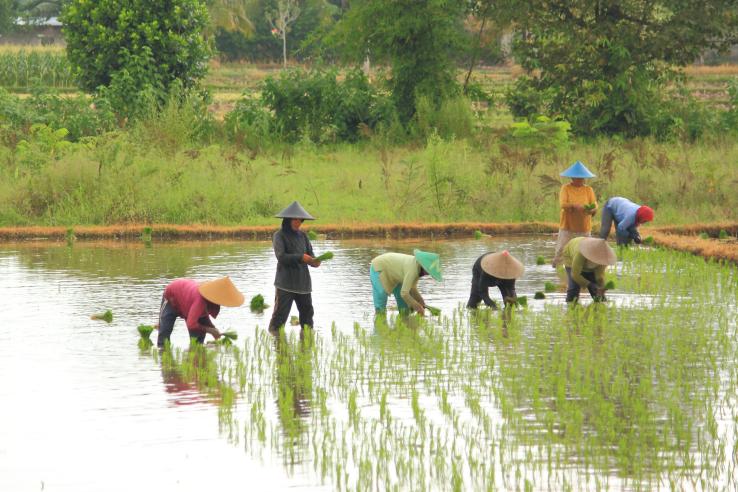Tailoring information to increase technology adoption among farmers

Photo credit: TK Kurikawa via Shutterstock.com
The climate crisis is one of the many factors contributing to rising global food insecurity and threatening farmer livelihoods. To complicate matters, farmers are also faced with navigating changes such as innovations in technology, evolving market structures, and new food standards. As such, they may no longer be able to rely on the same tools, knowledge, or experience that previously worked in their contexts. They need updated information that is accurate, tailored, easily accessible, and that aligns with their business priorities. J-PAL’s updated Policy Insight reviews strategies to improve information dissemination to help farmers make optimal production decisions and investments to improve their livelihoods.
Challenges in reaching farmers with information
Farmers access production information from many different sources, but information has traditionally been shared with farmers through government-led agricultural extension programs. These services, typically organized by agricultural ministries, consist of delivering trainings, field visits, or farmer field schools to large groups of farmers in rural areas with the goal to encourage them to adopt technologies and optimize their production practices. However, many extension systems face challenges with staff capacity and accountability to reach all farmers reliably. In addition, extension programs are designed to make recommendations that maximize yields. They often base their recommendations about which technologies to use on experimental evidence from tests of technologies under relatively controlled environments rather than under a variety of real-world conditions. As such, these recommendations do not often reflect farmers’ incentives to maximize profits, as many of the practices designed to increase productivity require upfront costs that are not always recouped when farmers sell their crops at harvest.
This mismatch in priorities results in low uptake of recommended technologies and highlights the urgency to better tailor extension services to farmers’ actual needs and local conditions, particularly in rapidly changing environments where best practices are evolving.
The Agricultural Technology Adoption Initiative (ATAI) is a joint research initiative with J-PAL and the Center for Effective Global Action, funded by the Bill & Melinda Gates Foundation and the UK Foreign, Commonwealth, & Development Office. Since 2009, ATAI-funded research has shown that despite the promise of agricultural technology to boost productivity and transform agricultural livelihoods, adoption of technology remains low. One such barrier farmers face in deciding whether to adopt a new practice or technology is a lack of access to timely and relevant information on how to best utilize and reap the greatest benefit from the technology in question.
New insights on how to better tailor and deliver information to help farmers adopt productive technologies
J-PAL affiliated researchers have tested interventions that help farmers better access information to assess the suitability of new technologies and make optimal farming decisions. In our updated Policy Insight, we reviewed 41 randomized evaluations—eighteen of which were funded by ATAI—that showed that the content, frequency, and channel by which information is disseminated plays an important role in a farmer’s decision to adopt a new technology. Providing farmers with information through extension services does help farmers make informed decisions about what technology to adopt, but these services do not always reach all farmers or do not deliver information that has been tailored to local contexts or production requirements. Strategies like harnessing a farmers’ local network, incorporating simple tools, and leveraging information and communication technologies (ICTs), can improve the effectiveness of information dissemination.
Peer farmers, who serve as role models and can draw on local knowledge to tailor extension messaging, can encourage farmers to adopt new or improved technologies. They are particularly effective when extension agents face low capacity and when trust in recommendations from more formal channels is low.
Providing farmers with tools that simplify the use of complex technologies, like pit planting, charts to monitor plant needs through leaf color tracking, or a spoon to measure the optimal fertilizer amount, are another effective strategy to increase the uptake of improved farming practices.
Incorporating ICTs, such as SMS, into extension services can help organizations deliver frequent reminders and tailored information to farmers at particular points during production and harvest. Videos are another innovative tool to deliver technical information consistently and in a digestible manner, especially in areas where literacy rates are low.
While farmers seem to learn from information and adjust their production decisions accordingly, this does not consistently lead to improvements in their yields or profits. This may be because the information originally shared with them was irrelevant, the technology promoted was ill suited for the farmers targeted, or the recommendations shared prioritized increasing yields over profits. As such, policymakers should do more to ensure that the technologies selected, the information defined, and the delivery mechanisms are relevant and well-aligned with local conditions and farmer priorities.
Timely, relevant, and accurate information is key
As climate change and other factors accelerate the development of innovative technology and practices, it is critical that farmers know what tools are available to them, how to best use them, and what benefits or costs they should expect from adoption. With better access to timely, relevant, and accurate information farmers in low- and middle-income countries will be better equipped to combat rising food insecurity across the globe.
This blog was originally drafted by J-PAL and posted on the J-PAL website.